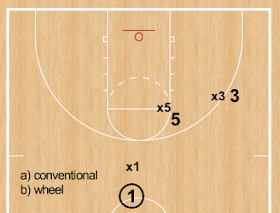With competitive personnel (talent) and coaching, many games are decided by a few points. Succeeding in those close and late situations informs exceptional versus mediocre performance.
Obvious needs are consistent free throw shooting, offensive and defensive "delay", defensive 'clarity' (dealing with the opponent's primary threat), and execution of special situations. But those discussions belong to other days.
"Trivial" differences in execution and positioning in 'non-critical' situations define success and failure. This might involve your or the opponent's 'handwork' or 'footwork'.
1. Automatic (alpha)
Against aggressive defense, playing 5 out opens the middle. Automatic action means the perimeter cutter goes backdoor (cut to the ball, then away) when the defender's foot crosses the "spacing line".
2. Blind pig.
Consider 'conventional' and 'option' action. With conventional 5 aligns near the post with her feet at a 45 degree angle (back to the opposite block)...5 gets an entry pass and 3 immediately cuts back door. With the 'wheel', 5 initial sets up back to the baseline. She gets entry and takes one dribble toward the opposite elbow. As she 'wheels' (pivots) on the left foot, 3 cuts back door, hoping to catch x3 distracted.
3. Attack the front hand/foot.
When a defender shows a 'forcing' stance, we teach 'attack the front hand/foot'. The defender can easily slide left. But with a 'rip through' move, the offensive player (off the catch), rips or swims (ball swung low) attacks the front foot with a crossover, forcing the defender to drop step.
4. Attack the pivot foot (defense).
When the offensive player picks up the ball, the defender calls 'pinch' and attacks the ball handler, straddling the pivot foot. This stops the player's capacity to front pivot and makes a more uncomfortable pass.
5. Deny the sideline.
What coach hasn't been driven mad by poor trapping technique, allowing the dribble to advance down the sideline?
- Teach "the glass box". Put the ballhandler in the box. Don't foul, just suffocate.
- Trappers inside feet should touch.
- Consider the sideline trapper having the outside foot on or over the line. The ballhandler cannot dribble outside a trapper with a foot at the line.
"Little things make big things happen." - Coach Wooden



